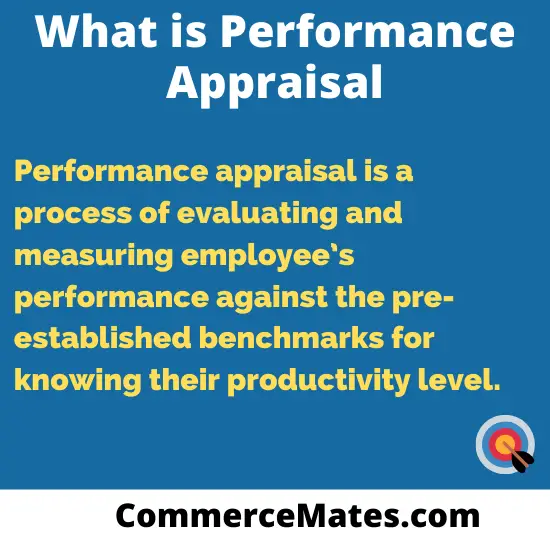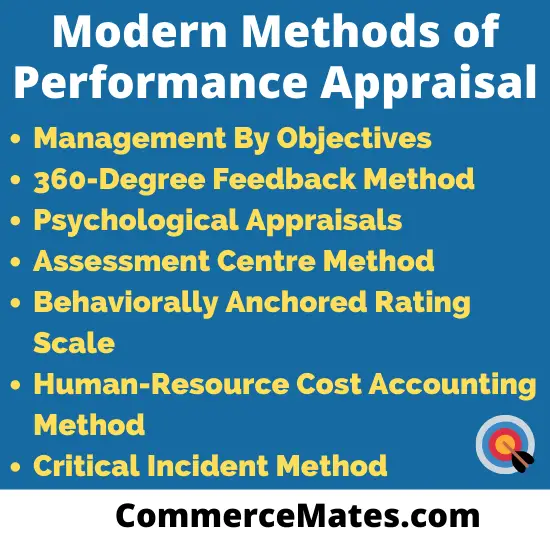Contents
What is Performance Appraisal?
Performance appraisal is a process of evaluating and measuring employee performance against the pre-established benchmarks for knowing their productivity level. It is an annual process carried out by an organization where first quantifiable goals and objectives are set and then used for accessing the performance of individuals. The results of the performance appraisal process are used by management in determining the wages and promotion of employees. This process is quite critical for the organization as it enables them in tracking the performance of employees, which is linked directly with business long-term growth. On the other hand, it also results in boosting employee productivity and enhances their outcomes.

Modern Methods of Performance Appraisal
Various modern methods of performance appraisal are as discussed below: –
Management by objectives (MBO)
Management by objectives is an appraisal method where management evaluates the employee’s performance in accordance with targets attained by them. The MBO method pays attention to enhancing organizational performance by defining goals clearly agreed upon by both managers as well as employees. Under this method, the manager and employee first identify, plan and communicate objectives to be considered during a particular appraisal period.
The objectives identified during the process are challenging yet achievable by employees. Now, the performance of employees is reviewed periodically by managers against the goals set initially which serve as the evaluation basis. All such pre-established goals which are not achieved by employees are recognized by the management team. Managers and employees decide on new strategies for attaining all such unachieved sets of goals. The practitioners of MBO believe that it boosts the employee’s morale and strengthens their relations with managers.
360-Degree Feedback method
360-degree feedback method is a multidimensional method where data on employee performance is acquired from the employee circle of influence such as managers, customers, direct reports, peers, team members, and self. It is the most common appraisal method which removes any biases in performance reviews. Here, the employee is asked to provide feedback on his own performance which enables him in recognizing his strengths and weaknesses.
In addition to this, team members are also asked to give their views on the assessee’s performance which enables employees to get an idea of what others think about him. This way employees are able to overcome their disbelief. Therefore, the 360-degree feedback method offers a diverse and detailed overview of employees from different perspectives.
Psychological Appraisals
Psychological appraisal is one of the frequently used modern methods of performance appraisal. This method instead of evaluating the past performance of employees pays attention to knowing their potential for future performance. The psychologist under this method assesses the employee for knowing their hidden qualities and potential. An in-depth examination, psychological tests, interview, discussions with superiors,s and review of other sorts of evaluation is conducted by a psychologist.
All these types of assessments enable knowing the motivational, intellectual, emotional, and various key qualities of workers which are necessary for knowing their potential for future performance. However, the psychological appraisal method is a complex, slow, and costly process and in addition to this quality is dependent upon the psychologist who administers the whole process.
Assessment Centre method
The assessment center method comes up in year 1930s by the German army, which was revamped in order to meet the present business scenario. Here, all managers are asked to gather at one central location and perform different job exercises. The assessee is asked for participating in in-basket exercises, computer simulations, discussions, role-playing exercises, etc. Now they all are evaluated in terms of their persuasive ability, administrative ability, level of sensitivity to others, communication skills, confidence level, mental alertness, etc.
All these exercises are carried out under the observance of trainers who keep eye on employees’ behavior. The trainer, later on, discusses the same with the rater, who finally take decisions on the performance of employees.

Behaviorally Anchored Rating Scale (BARS)
A behaviorally anchored rating scale (BARS) is one of the effective methods which brings out both quantitative as well as qualitative benefits of the performance appraisal process. Under it, the performance of employees is compared by the employer with particular behavioral examples which are anchored to numerical ratings. Every level of performance on the BAR scale is anchored by distinct BARS statements, showing common behavior which may be exhibited by an employee on a routine basis. Such statements serve as a yardstick for measuring the performance of individuals against a predetermined set of standards applicable to their job level.
The process of BARS creation begins with the creation of critical incidents which depict the typical work area behavior. In the next step, the critical incidents are now edited into a common format for removing any redundancy. Once they are normalized, randomization of critical instances is done and checked for effectiveness. The critical incidents which are left are utilized for generating BARS and checking the performance of employees.
Human-resource Cost accounting method
The human resource cost accounting method is one under which monetary yields provided to an organization by an employee are taken into consideration for knowing his/her performance. This method focuses on comparing the cost to the company of retaining employees with the benefits in monetary terms achieved by the organization from that specific employee.
In addition to it, this method while assessing employee performance also consider factors such as overhead cost, quality, relationship on an interpersonal level, unit-wise average service value, and many other aspects. However, they are drawbacks also in human-resource cost accounting methods such as high dependency on cost as well as benefit analysis, and the memory power of the reviewer.
Critical incident method
The critical incident method involves evaluating the performance of employees on the basis of certain events which are termed as “critical incidents”. The employees under this method either fail in any of the given tasks or succeed in it tremendously. The person who is evaluating during the process keeps a full record of all details related to distinct incidents in the form of a digital or physical journal.
Critical incident method via maintaining a digital record of both positive and opportunity areas for employees, an employer is able to provide a detailed feedback on their subordinates. This way the overall chances of employee development in future gets enhanced.